Tràns Peugeot 307 SW 2002 Owner's Manual
[x] Cancel search | Manufacturer: PEUGEOT, Model Year: 2002, Model line: 307 SW, Model: Peugeot 307 SW 2002Pages: 137, PDF Size: 1.43 MB
Page 7 of 137
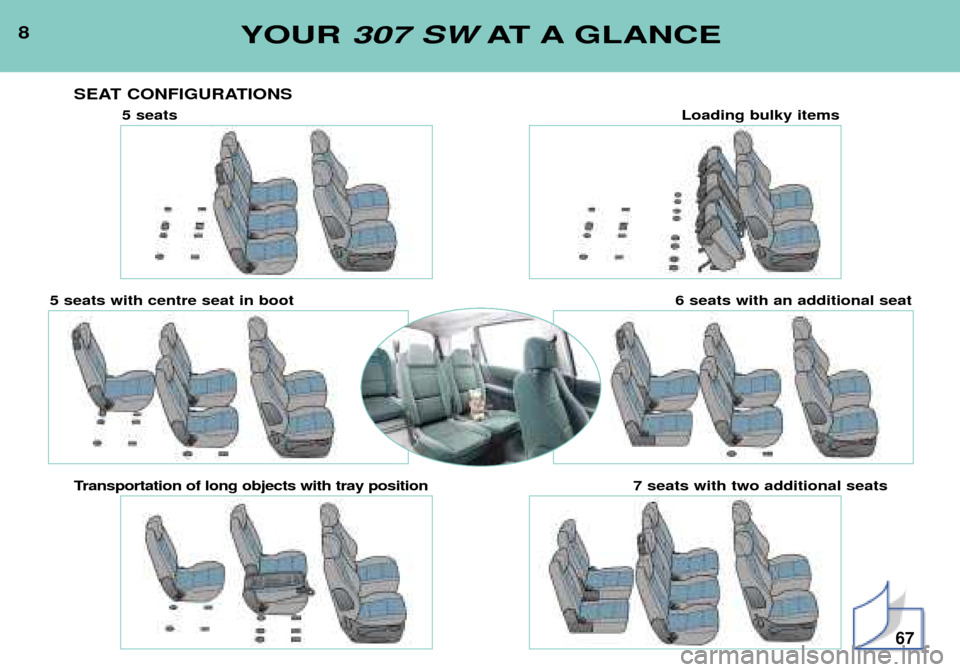
8YOUR 307 SW AT A GLANCE
SEAT CONFIGURATIONS
67
5 seats Loading bulky items
5 seats with centre seat in boot 6 seats with an additional seat
Transportation of long objects with tray position 7 seats with two additional seats
Page 23 of 137
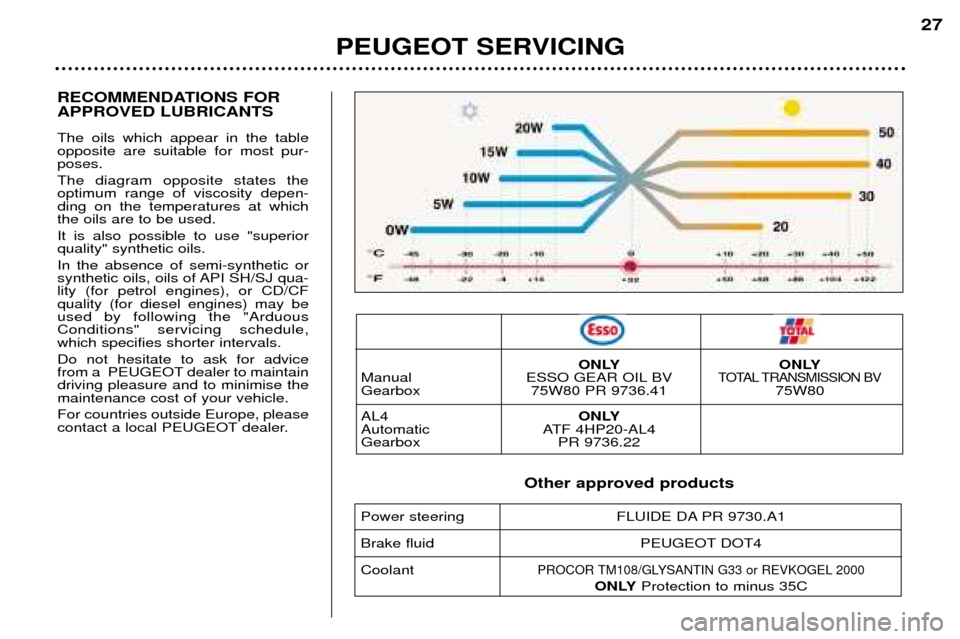
RECOMMENDATIONS FOR APPROVED LUBRICANTS The oils which appear in the table opposite are suitable for most pur-poses. The diagram opposite states the optimum range of viscosity depen-ding on the temperatures at whichthe oils are to be used. It is also possible to use "superior quality" synthetic oils. In the absence of semi-synthetic or
synthetic oils, oils of API SH/SJ qua-lity (for petrol engines), or CD/CFquality (for diesel engines) may beused by following the "ArduousConditions" servicing schedule,which specifies shorter intervals. Do not hesitate to ask for advice
from a PEUGEOT dealer to maintaindriving pleasure and to minimise themaintenance cost of your vehicle. For countries outside Europe, please
contact a local PEUGEOT dealer.
PEUGEOT SERVICING27
ONLY ONLY
Manual ESSO GEAR OIL BVTOTAL TRANSMISSION BVGearbox 75W80 PR 9736.41 75W80 AL4 ONLY
Automatic ATF 4HP20-AL4
Gearbox PR 9736.22
Other approved products
Power steering FLUIDE DA PR 9730.A1
Brake fluid PEUGEOT DOT4 Coolant
PROCOR TM108/GLYSANTIN G33 or REVKOGEL 2000
ONLYProtection to minus 35C
Page 26 of 137
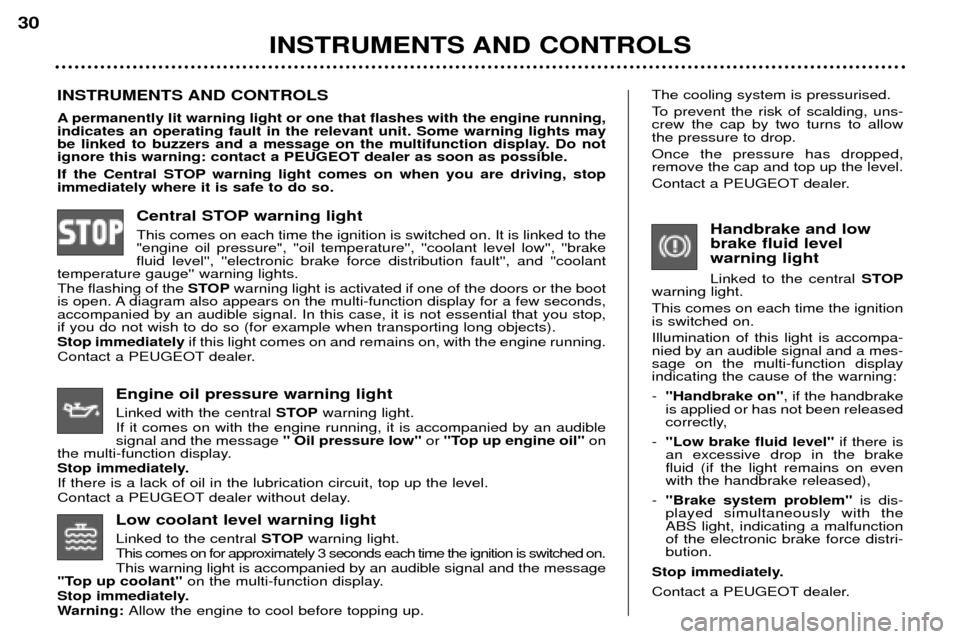
Low coolant level warning light Linked to the centralSTOPwarning light.
This comes on for approximately 3 seconds each time the ignition is switched on. This warning light is accompanied by an audible signal and the message
"Top up coolant" on the multi-function display.
Stop immediately.
Warning: Allow the engine to cool before topping up.Central STOP warning light This comes on each time the ignition is switched on. It is linked to the "engine oil pressure", ''oil temperature'', ''coolant level low'', ''brakefluid level'', ''electronic brake force distribution fault'', and ''coolant
temperature gauge'' warning lights. The flashing of the STOPwarning light is activated if one of the doors or the boot
is open. A diagram also appears on the multi-function display for a few seconds, accompanied by an audible signal. In this case, it is not essential that you stop,if you do not wish to do so (for example when transporting long objects). Stop immediately if this light comes on and remains on, with the engine running.
Contact a PEUGEOT dealer.
Engine oil pressure warning light Linked with the central STOPwarning light.
If it comes on with the engine running, it is accompanied by an audible signal and the message '' Oil pressure low''or ''Top up engine oil'' on
the multi-function display.
Stop immediately.If there is a lack of oil in the lubrication circuit, top up the level.
Contact a PEUGEOT dealer without delay.
INSTRUMENTS AND CONTROLS
A permanently lit warning light or one that flashes with the engine running, indicates an operating fault in the relevant unit. Some warning lights may
be linked to buzzers and a message on the multifunction display. Do notignore this warning: contact a PEUGEOT dealer as soon as possible.
If the Central STOP warning light comes on when you are driving, stop immediately where it is safe to do so. The cooling system is pressurised.
To prevent the risk of scalding, uns- crew the cap by two turns to allowthe pressure to drop. Once the pressure has dropped, remove the cap and top up the level.
Contact a PEUGEOT dealer.
Handbrake and low brake fluid levelwarning light Linked to the central STOP
warning light. This comes on each time the ignition is switched on. Illumination of this light is accompa- nied by an audible signal and a mes-sage on the multi-function displayindicating the cause of the warning: - ''Handbrake on'' , if the handbrake
is applied or has not been released
correctly,
- ''Low brake fluid level'' if there is
an excessive drop in the brakefluid (if the light remains on evenwith the handbrake released),
- "Brake system problem'' is dis-
played simultaneously with theABS light, indicating a malfunctionof the electronic brake force distri-bution.
Stop immediately.
Contact a PEUGEOT dealer.
INSTRUMENTS AND CONTROLS
30
Page 37 of 137
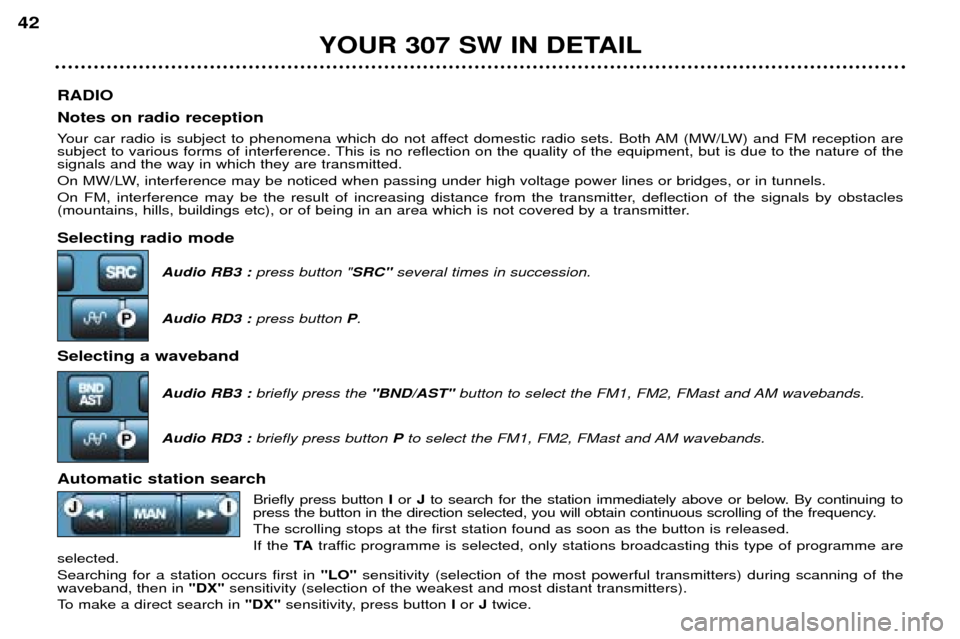
RADIO Notes on radio reception
Your car radio is subject to phenomena which do not affect domestic radio sets. Both AM (MW/LW) and FM reception are
subject to various forms of interference. This is no reflection on the quality of the equipment, but is due to the nature of the
signals and the way in which they are transmitted.
On MW/LW, interference may be noticed when passing under high voltage power lines or bridges, or in tunnels.
On FM, interference may be the result of increasing distance from the transmitter, deflection of the signals by obstacles
(mountains, hills, buildings etc), or of being in an area which is not covered by a transmitter. Selecting radio mode
Audio RB3 : press button " SRC"several times in succession.
Audio RD3 : press button P.
Selecting a waveband Audio RB3 : briefly press the "BND/AST"button to select the FM1, FM2, FMast and AM wavebands.
Audio RD3 : briefly press button Pto select the FM1, FM2, FMast and AM wavebands.
Automatic station search Briefly press buttonIor Jto search for the station immediately above or below. By continuing to
press the button in the direction selected, you will obtain continuous scrolling of the frequency. The scrolling stops at the first station found as soon as the button is released.If the TAtraffic programme is selected, only stations broadcasting this type of programme are
selected.Searching for a station occurs first in "LO"sensitivity (selection of the most powerful transmitters) during scanning of the
waveband, then in "DX"sensitivity (selection of the weakest and most distant transmitters).
To make a direct search in "DX" sensitivity, press button Ior Jtwice.
YOUR 307 SW IN DETAIL
42
Page 39 of 137

RDS Using the RDS (Radio Data System) function on FM Radio Data System allows you to continue listening to the same station whatever frequency it is using for the region you are going through.Briefly press the "RDS"button to switch the function on or off.
The multifunction display wil show: - "RDS" if the function is selected.
- "(RDS)" if the function is selected but not available.
RDS station following
The display indicates the name of the station selected. The radio is continually searching for the station which has the best reception and which is transmitting the same programme.
Traffic information programme Press the"TA"button to switch the function on or off.
The multifunction display will show: - "TA" if the function is selected,
- "(TA)" if the function is selected but not available.
Any traffic information flash will be given priority, whatever source you are listening to (radio, cassette, CD or CD changer).If you wish to interrupt a message, press the "TA"button; this switches the function off.
Note : the volume of traffic information announcements is independent of the volume of normal radio listening. You can adjust it using the volume button. The setting will be stored and will be used when the next messages are broadcast.
Regional following mode When they are part of a network, certain stations broadcast regional programmes in the various areas they serve. With regio- nal following mode you can keep listening to the same programme. Press the "RDS"button for more than two seconds to switch the function on or off.
YOUR 307 SW IN DETAIL
44
Page 44 of 137
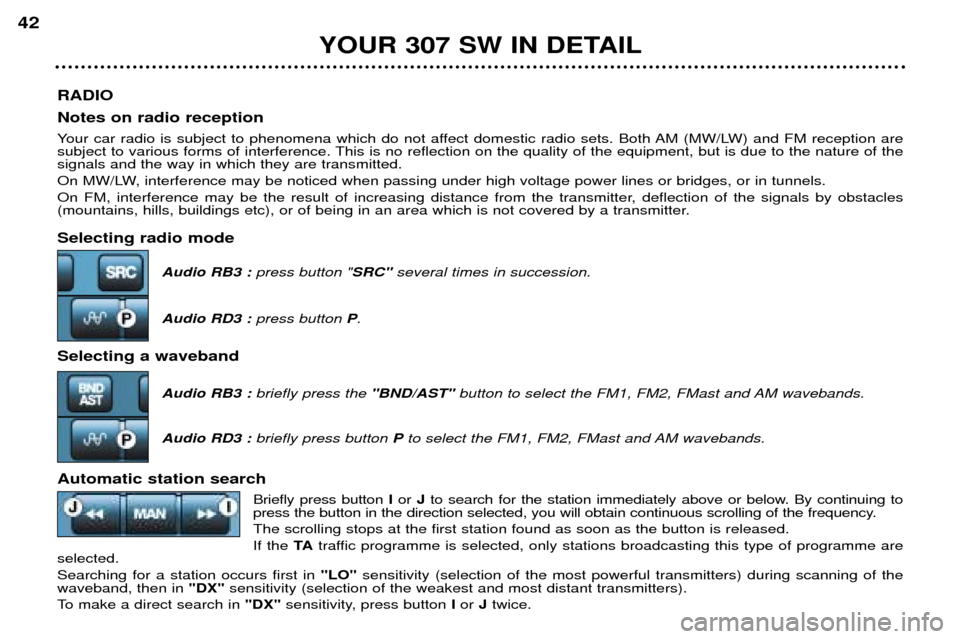
RADIO Notes on radio reception
Your car radio is subject to phenomena which do not affect domestic radio sets. Both AM (MW/LW) and FM reception are
subject to various forms of interference. This is no reflection on the quality of the equipment, but is due to the nature of the
signals and the way in which they are transmitted.
On MW/LW, interference may be noticed when passing under high voltage power lines or bridges, or in tunnels.
On FM, interference may be the result of increasing distance from the transmitter, deflection of the signals by obstacles
(mountains, hills, buildings etc), or of being in an area which is not covered by a transmitter. Selecting radio mode
Audio RB3 : press button " SRC"several times in succession.
Audio RD3 : press button P.
Selecting a waveband Audio RB3 : briefly press the "BND/AST"button to select the FM1, FM2, FMast and AM wavebands.
Audio RD3 : briefly press button Pto select the FM1, FM2, FMast and AM wavebands.
Automatic station search Briefly press buttonIor Jto search for the station immediately above or below. By continuing to
press the button in the direction selected, you will obtain continuous scrolling of the frequency. The scrolling stops at the first station found as soon as the button is released.If the TAtraffic programme is selected, only stations broadcasting this type of programme are
selected.Searching for a station occurs first in "LO"sensitivity (selection of the most powerful transmitters) during scanning of the
waveband, then in "DX"sensitivity (selection of the weakest and most distant transmitters).
To make a direct search in "DX" sensitivity, press button Ior Jtwice.
YOUR 307 SW IN DETAIL
42
Page 46 of 137

RDS Using the RDS (Radio Data System) function on FM Radio Data System allows you to continue listening to the same station whatever frequency it is using for the region you are going through.Briefly press the "RDS"button to switch the function on or off.
The multifunction display wil show: - "RDS" if the function is selected.
- "(RDS)" if the function is selected but not available.
RDS station following
The display indicates the name of the station selected. The radio is continually searching for the station which has the best reception and which is transmitting the same programme.
Traffic information programme Press the"TA"button to switch the function on or off.
The multifunction display will show: - "TA" if the function is selected,
- "(TA)" if the function is selected but not available.
Any traffic information flash will be given priority, whatever source you are listening to (radio, cassette, CD or CD changer).If you wish to interrupt a message, press the "TA"button; this switches the function off.
Note : the volume of traffic information announcements is independent of the volume of normal radio listening. You can adjust it using the volume button. The setting will be stored and will be used when the next messages are broadcast.
Regional following mode When they are part of a network, certain stations broadcast regional programmes in the various areas they serve. With regio- nal following mode you can keep listening to the same programme. Press the "RDS"button for more than two seconds to switch the function on or off.
YOUR 307 SW IN DETAIL
44
Page 69 of 137
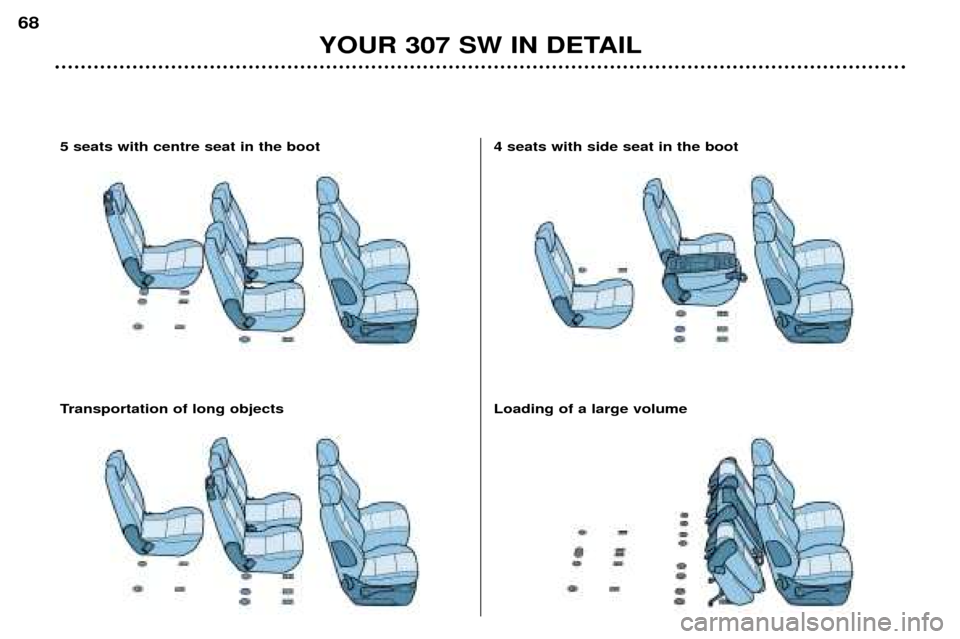
YOUR 307 SW IN DETAIL
68
4 seats with side seat in the boot Loading of a large volume5 seats with centre seat in the boot
Transportation of long objects
Page 129 of 137

TOWING A TRAILER,
CARAVAN, BOAT ETC.
Only use original PEUGEOT tow bars that have been tested andapproved from the design stage of
your vehicle. The tow bar must be fit-
ted by a PEUGEOT dealer.
Your vehicle is basically designed for transporting people and luggage butit may also be used for towing a trai-
ler. Driving with a trailer subjects the towing vehicle to more significantstress and its driver must be particu-larly careful. Air density decreases with altitude, thus reducing engine performance.Above 1000 metres, the maximumtowing load must be reduced by 10%and so on for every 1000 metres ofaltitude.Driving advice Distribution of loads Distribute the load in the trailer so that the heaviest items are as closeas possible to the axle and the noseweight approaches the maximumpermitted without exceeding it. Cooling
Towing a trailer on a slope increases the temperature of the coolant. As the fan is electrically controlled, its cooling capacity is not dependenton the engine speed.
On the contrary, use a high gear to lower the engine speed, and reduceyour speed. The maximum towing load on a long slope depends on the gradient andthe outside temperature. In all cases, pay attention to the coolant temperature. If the warning light comes on, stop
the vehicle and switch off the engineas soon as possible.Tyres Check the tyre pressures of the
towing vehicle and of the trailer,observing the recommended pres-sures. Braking
Towing increases the braking distance. Lights Adjust your headlamps so that they do not dazzle other road users.Check the electrical signalling on the
trailer. Side wind
Take into acount the increased sen- sitivity to side wind.
PRACTICAL INFORMATION
121
Page 130 of 137

REMOVING THE MAT When removing the mat on the dri- ver's side, push the seat as far backas possible and unscrew the fixings. When refitting, position the mat and replace the fixings by pressing themin.FITTING ROOF BARS When fitting transverse roof bars, ensure that they are positioned cor-
rectly. The correct positions are shown by marks on each of the longitudinalbars.Use accessories approved by
PEUGEOT and follow the manufac-turer's fitting instructions.
PRACTICAL INFORMATION
122
Maximum authorised weight on
the roof rack: 100 kg